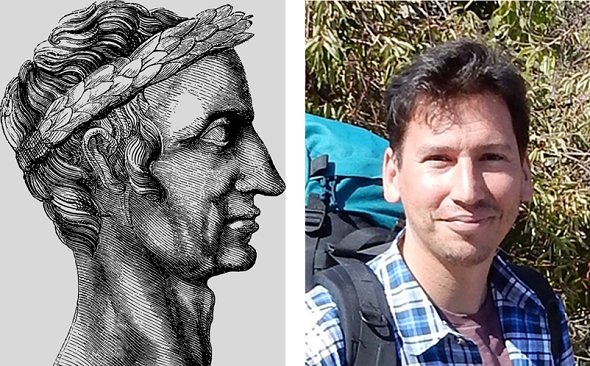Blog reader Christoph Tenzer has sent me a nice crypto challenge, based on an enhanced Caesar cipher. Can a reader solve it?
The homophonic Polybius challenge I introduced a few days ago was solved immediately by my readers Dave Oranchak and Nils Kopal. Both used hill climbing software designed to attack homophonic ciphers. Of course, I knew tools of this kind, but – to be honest – I didn’t think that they were powerful enough to break a 200-letter plaintext encrypted with a method that provides six homophones for every character of the alphabet.
Blog reader Knox suggested that instead of one alphabet (15 letters above the matrix, 10 left of it), two (25 letters above the matrix, 25 left of it) should be used to create homophones. This would result in 25 homophones per character of the alphabet. I think I will come back to this concept in the near future.
The chaotic Caesar cipher
My article about the homophonc Polybius triggered long-time blog reader Christoph Tenzer …
… to send me the following description of a cipher he calls “chaotic Cesar”. It is based on the Caesar cipher, a simple letter substitution using a shifted alphabet, known for more than 2000 years. He then borrows two additional concepts from other manual ciphers.
In the following, we work with the standard English 26-letter alphabet. We need a keyword and a number n. As an example, we take the keyword CHALLENGE and n=3. The keyword is used to rearrange the alphabet in the usual way: Write the keyword first, omit repeating letters, append the remaining letters. For CHALLENGE, we receive:
CHALENGBDFIJKMOPQRSTUVWXYZ.
To encrypt a plaintext, one starts with the first letter and performs the following steps (in the first step, the number n comes into play):
- Find the position of the plaintext letter in the cipher alphabet. The ciphertext letter is the one n steps to the right (continue counting from the left if you reach the end).
- Switch the position of plaintext and ciphertext letter in the cipher alphabet.
- Continue with the next plaintext letter.
Using the keyword CHALLENGE and n=3, the plaintext TO BE OR NOT TO BE is encrypted as follows:
- T returns W and then the positions of T and W are switched, so the alphabet is now: CHALENGBDFIJKMOPQRSWUVTXYZ
- O returns R and then the positions of O and R are switched, and the alphabet is now: CHALENGBDFIJKMRPQOSWUVTXYZ
- B returns I and then the positions of B and I are switched, and the alphabet is now: CHALENGIDFBJKMRPQOSWUVTXYZ
- E returns I and so on…
Here’s the ciphertext: WRIIUUDXZACMM
Decryption works almost the same way, starting with the first ciphertext letter and the original cipher alphabet:
- Find the position of the ciphertext letter in the cipher alphabet and the cleartext letter is the one n steps to the LEFT (continue from the right if you reach the beginning).
- Switch the position of cleartext and ciphertext letter in the cipher alphabet.
- Continue with the next ciphertext letter.
In our example, the original cipher alphabet was: CHALENGBDF IJKMOPQRS TUVWXYZ and n=3. Thus, W returns T, R returns O and so on… until we receive TOBEORNOTTOBE.
Christoph’s Chaotic Caeasar Cipher Challenge
Christoph has encrypted the following ciphertext with the chaotic Cesar cipher:
YWXHZVFKTLJIPQPUHUSIEUNPXWTXHA SLAADEOVXNDZJYRPUBKUGHSPXMOEPJ TZITGQQRLXXERRJCJQPXICKJECPDZD MLUIDAHZRDFWUZPMXLSHUNJIXMDUEN TZIIDSESYHBVEXSIUMPTZIJPDJNISE DERHHTYAQHEMTIRAICENTZMJXNDNVD BZLXTTLITCCDOOJSJESIIWPXJJNDUN PBBSLPSIAFRCRPAFIXRTKLQIRBIXSI WSRBEDANUUXAIDCTCEHYZOZARZRUXU HMCISUWEABIPDEJOZLERYTAERATETL ZRZXAAOZKXIUWNPSYDZSIGPZJBZRKQ LXSTSITYKKXHGXDWIXPRXOVRQTQFXX IVJOSBZDNOPWLFLNIOP
The plaintext is in English, consisting of 379 letters. The keyword is not a single word and has more than 10 different letters, which means that a dictionary or brute force attack probably won’t work. The number n was chosen randomly between 1 and 25.
Thank you very much, Christoph, for this crypto challenge. Can a reader solve it?
Follow @KlausSchmeh
Further reading: Rubik’s Cube encryption challenge solved
Linkedin: https://www.linkedin.com/groups/13501820
Facebook: https://www.facebook.com/groups/763282653806483/




Kommentare (30)